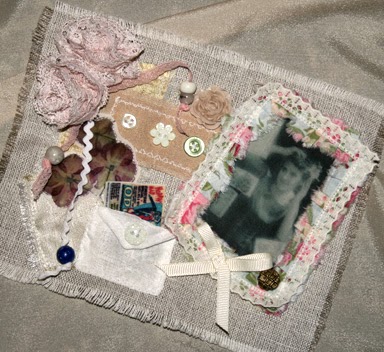It changes the creation process. Rather than starting with a doodle, a word, a stain and adding outlines, colored pencils, markers, paint and ephemera, I need more time to gather fabrics, plan, stitch, actually design the page. The final product changes and grows as the page develops, but it is not as fluid and spontaneous. On the other hand, I can rip out stitches and change easier than ink on paper.
Process decisions are more complicated, how to add words, machine stitch, hand written on fabric, embroidered? How do I attach something that has no loops like sticks and feathers? Will glue hold or ruin the piece?
But the result is amazing. A piece with a tactile presence that paper doesn't have. Give it a try.
- Start with a favorite piece of fabric or muslin. Don't forget old favorite shirts or dresses for backings.
- Gather buttons, ribbon, beads, ephemeral, lace, embellishments from old clothes, old jewelry, fabric scraps.
- Layout items, rearrange, add, subtract. When you are happy with the arrangement. Take a picture.
- Now remove the top layers. Hand or machine stitch the back objects.
- Using the photo, add another layer and stitch or glue the items. Add another layer. By this stage, you are probably hand stitching. Tuck in ribbons, feathers, add beads to dangling items.
- Stand back. Add something else. Think about it, add more.
- Don't forget pockets (stitch 3 sides of a patch or scrap, leave the fourth open) to tuck in tickets or memorabilia. Buttons off those old clothes add depth. Pressed flowers can be secured under netting or a piece from an old sheer curtain.
- Write a word with Sharpie on a scrap of fabric and secure. Or stitch a phrase with embroidery floss.
